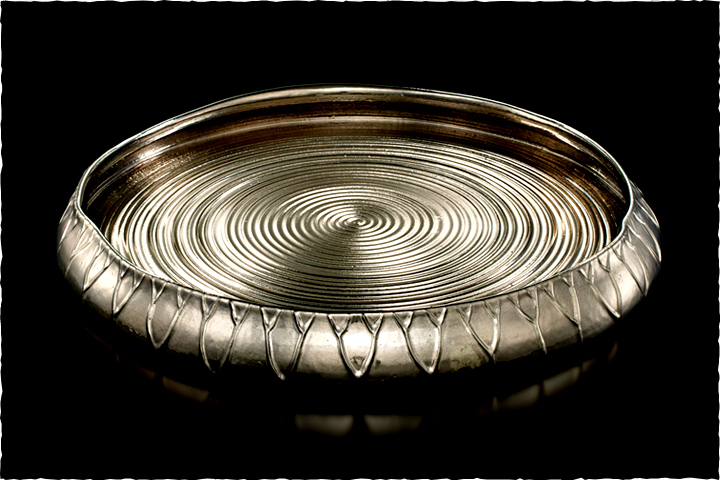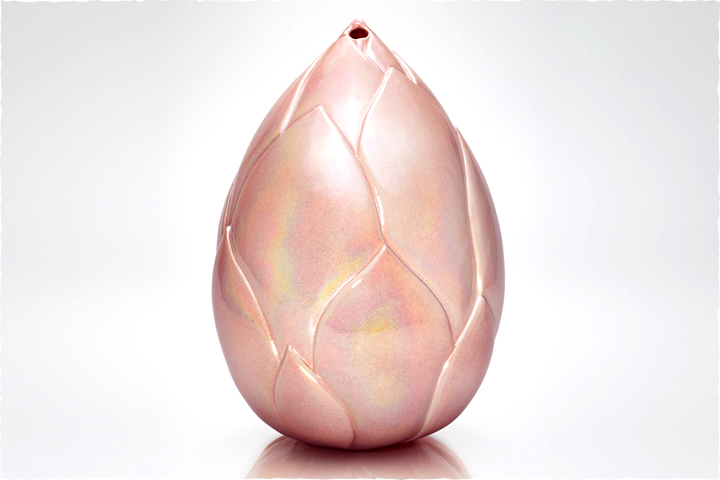

Lotus of Love
Toshio Shimizu
For thousands of years, human beings have seen the lotus flower as an entity transcending space and time. They have also seen the space above the lotus as precious and sacred. The lotus has been on a long journey from Egypt to India, China, Korea, and Japan, and it is interesting that people in many times and places have had the same feelings about the lotus.
In any case, at the end of this journey, the lotus is still blooming in the same way, as a noble and cosmic flower, in the studio of Hanako Miwa in Hagi, a small town in a far corner of Japan.
Hanako Miwa's lotus flowers are made of ceramic. In addition to paintings and sculpture, there is a Japanese art called ikebana (flower arrangement) that gives eternal beauty to plants, which have a limited life. Even so, Hanako Miwa has chosen to create her forms with ceramic. That is because ceramic is the material with which she is most familiar.
The town of Hagi is famous for Hagi pottery. Hagi ceramic ware has great beauty because of its soft, reddish clay seen indistinctly through translucent glazes. It goes back to the 17th century, and the Miwa family can be traced to the beginnings of Hagi ware. The first Kyusetsu Miwa received a gift of land from the Hagi domain and built a kiln in the Kanbun era (1661-1672), so the family has a 350-year history. Hanako, her grandfather, her father, and her uncle were all raised in an environment that brought them close to clay. However, she only began making ceramic art about five years ago. After studying sculpture at art school, she went to England for further study, and after experimenting with a variety of techniques, concentrating on "interactive art," she finally settled on ceramics.
Hanako Miwa showed an amazing talent for handling clay right from the beginning. At the time I saw her first show, "Myō" (Wonder), in 2001, I was aware that she had deliberately attempted to create art without form while in England. I remember feeling more than a little surprised at the sureness of her skills in creating form. However, Miwa is not just a simple ceramic artist. She applies precise technical skills to every work as she continues to develop her work, but this work is the result of a will to express something formless. Her recent work can be described as an extension of a creative approach transcending the five senses, including sight and touch, that began in her English period, to which I have referred above.
Let us think about this in relation to the present work. This work is titled Love Lotus. As this title indicates, it is composed of lotus flowers and lotus pads. The lotus flowers include fully blooming flowers and buds. They seem to float in empty space next to the pads. In nature, lotus flowers ordinarily bloom on water, but in this work, according to the artist, they are floating in the empty space of the universe. The pads are treated with platinum luster and have a tough, metallic sheen. They look like silver trays.
According to Miwa's statement, this work contains all of the meanings that people have given to the lotus since ancient times in Egypt, as mentioned at the beginning of this essay. The lotus is a noble flower and it becomes a site where love resides. It symbolizes the continuing existence of this condition in eternal time.
How does Miwa express the formlessness of eternity? She uses a mirror.
A stainless steel mirror is placed behind the work like a screen. There is a light hair line on the surface that prevents it from reflecting perfectly, so the image that appears on the mirror is semi-transparent and softly focused.
The mirror is a deceptive device. It reflects this world, but what is actually reflected is actually an empty image, fantasmagoria without content. This idea is based on the premise that truth is found in the world. If this world is empty, if it exists in a place transcending phenomena, the mirror itself might be thought of as reflecting its true form.
Miwa has used the mirror's capacity for reflecting the opposites of truth or falsehood to show the true form of an actually existing ceramic lotus, which is an embodiment of eternity. It goes without saying that eternity as such is not found in ceramic materials. They only last for tens of thousands of years. The actual image of the lotus in the mirror, however, floats in the eternal cosmos.
Thus, Miwa skillfully gives visual form to the eternity of the lotus. We catch a glimpse of eternity reflected in the mirror. We can only see it vaguely, but this cannot be helped because it is a living thing with a limited life. Let us look at it intently enough to see the true form of the pure lotus beyond the mirror, even if this vision can only be vague. It is pleasant to sit and contemplate these lotus flowers briefly, thinking about the long journey they are on.
Love Lotus
![]()
![]()
![]()

Photo: Takayoshi Nakanishi
Lotus pad: Stoneware with platinum luster H9.5 x W85cm
Lotus bud: Stoneware H33.7 x W23cm
